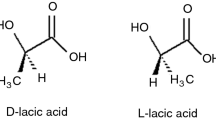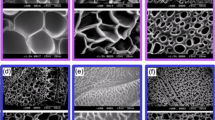Abstract
The precipitation inhibitory effect of cellulosic polymers in relation to their physicochemical properties was studied. Using a poorly water-soluble model drug, griseofulvin, the precipitation inhibitory effect of a series of hydroxypropyl methylcellulose (HPMC) and methylcellulose polymers was studied using solvent–shift method. The extent of supersaturation maintenance of each polymer was then quantified by the parameter, supersaturation factor (SF). Partial least square (PLS) regression analysis was employed to understand the relative contribution from viscosity, hydroxypropyl content (HC), methoxyl content, methoxyl/hydroxypropyl ratio, and drug–polymer interaction parameter (χ) on SF. All grades of cellulosic polymers effectively prolonged supersaturation of griseofulvin. PLS regression analysis revealed that HC and χ appeared to have the strongest influence on SF response. A regression model of SF = 1.65–0.16 χ + 0.05 HC with a high correlation coefficient, r of 0.921, was obtained. Since the value of χ is inversely related to the strength of drug–polymer interaction, the result shows that SF increases with increasing drug–polymer interaction and increasing HC. As such, it can be implied that strong drug–polymer interaction and presence of hydroxypropyl groups in cellulosic polymers for hydrogen bonding are two key parameters for effective supersaturation maintenance. This knowledge on the relative contribution of polymer physicochemical properties on precipitation inhibition will allow the selection of suitable cellulosic polymers for systematic development of supersaturating drug delivery systems.







Similar content being viewed by others
References
Hancock BC, Parks M. What is the true solubility advantage for amorphous pharmaceuticals? Pharm Res. 2000;17(4):397–404.
Qian F, Wang J, Hartley R, Tao J, Haddadin R, Mathias N, et al. Solution behavior of PVP-VA and HPMC-AS-based amorphous solid dispersions and their bioavailability implications. Pharm Res. 2012;29(10):2766–76.
Hong S, Shen S, Tan DC, Ng WK, Liu X, Chia LS, et al. High drug load, stable, manufacturable and bioavailable fenofibrate formulations in mesoporous silica: a comparison of spray drying versus solvent impregnation methods. Drug delivery. 2016;23(1):316–27.
Van Speybroeck M, Mellaerts R, Mols R, Thi TD, Martens JA, Van Humbeeck J, et al. Enhanced absorption of the poorly soluble drug fenofibrate by tuning its release rate from ordered mesoporous silica. Eur J Pharm Sci. 2010;41(5):623–30.
Brouwers J, Brewster ME, Augustijns P. Supersaturating drug delivery systems: the answer to solubility-limited oral bioavailability? J Pharm Sci. 2009;98(8):2549–72.
Serajuddin AT. Solid dispersion of poorly water-soluble drugs: early promises, subsequent problems, and recent breakthroughs. J Pharm Sci. 1999;88(10):1058–66.
Alonzo D, Zhang GZ, Zhou D, Gao Y, Taylor L. Understanding the behavior of amorphous pharmaceutical systems during dissolution. Pharm Res. 2010;27(4):608–18.
Alonzo DE, Gao Y, Zhou D, Mo H, Zhang GGZ, Taylor LS. Dissolution and precipitation behavior of amorphous solid dispersions. J Pharm Sci. 2011;100(8):3316–31.
Warren DB, Benameur H, Porter CJ, Pouton CW. Using polymeric precipitation inhibitors to improve the absorption of poorly water-soluble drugs: a mechanistic basis for utility. J Drug Target. 2010;18(10):704–31.
Overhoff K, McConville J, Yang W, Johnston K, Peters J, Williams R III. Effect of stabilizer on the maximum degree and extent of supersaturation and oral absorption of tacrolimus made by ultra-rapid freezing. Pharm Res. 2008;25(1):167–75.
Xu S, Dai WG. Drug precipitation inhibitors in supersaturable formulations. Int J Pharm. 2013;453(1):36–43.
Vandecruys R, Peeters J, Verreck G, Brewster ME. Use of a screening method to determine excipients which optimize the extent and stability of supersaturated drug solutions and application of this system to solid formulation design. Int J Pharm. 2007;342(1–2):168–75.
Chauhan H, Hui-Gu C, Atef E. Correlating the behavior of polymers in solution as precipitation inhibitor to its amorphous stabilization ability in solid dispersions. J Pharm Sci. 2013;102(6):1924–35.
Lindfors L, Forssén S, Westergren J, Olsson U. Nucleation and crystal growth in supersaturated solutions of a model drug. J Colloid Interface Sci. 2008;325(2):404–13.
Bevernage J, Hens B, Brouwers J, Tack J, Annaert P, Augustijns P. Supersaturation in human gastric fluids. European journal of pharmaceutics and biopharmaceutics: official journal of Arbeitsgemeinschaft fur Pharmazeutische Verfahrenstechnik eV. 2012;81(1):184–9.
Miller DA, DiNunzio JC, Yang W, McGinity JW, Williams RO 3rd. Enhanced in vivo absorption of itraconazole via stabilization of supersaturation following acidic-to-neutral pH transition. Drug Dev Ind Pharm. 2008;34(8):890–902.
Yang X, Shen B, Huang Y. Mechanistic study of HPMC-prolonged supersaturation of hydrocortisone. Cryst Growth Des. 2015;15(2):546–51.
Curatolo W, Nightingale JA, Herbig SM. Utility of hydroxypropylmethylcellulose acetate succinate (HPMCAS) for initiation and maintenance of drug supersaturation in the GI milieu. Pharm Res. 2009;26(6):1419–31.
Suzuki H, Sunada H. Influence of water-soluble polymers on the dissolution of nifedipine solid dispersions with combined carriers. Chemical & pharmaceutical bulletin. 1998;46(3):482–7.
Dukeck R, Sieger P, Karmwar P. Investigation and correlation of physical stability, dissolution behaviour and interaction parameter of amorphous solid dispersions of telmisartan: a drug development perspective. Eur J Pharm Sci. 2013;49(4):723–31.
Gao P, Guyton ME, Huang T, Bauer JM, Stefanski KJ, Lu Q. Enhanced oral bioavailability of a poorly water soluble drug PNU-91325 by supersaturatable formulations. Drug Dev Ind Pharm. 2004;30(2):221–9.
Ilevbare GA, Liu H, Edgar KJ, Taylor LS. Maintaining supersaturation in aqueous drug solutions: impact of different polymers on induction times. Cryst Growth Des. 2012;13(2):740–51.
Raina SA, Van Eerdenbrugh B, Alonzo DE, Mo H, Zhang GGZ, Gao Y, et al. Trends in the precipitation and crystallization behavior of supersaturated aqueous solutions of poorly water-soluble drugs assessed using synchrotron radiation. J Pharm Sci. 2015;104(6):1981–92.
Ozaki S, Kushida I, Yamashita T, Hasebe T, Shirai O, Kano K. Inhibition of crystal nucleation and growth by water-soluble polymers and its impact on the supersaturation profiles of amorphous drugs. J Pharm Sci. 2013;102(7):2273–81.
Tian F, Saville DJ, Gordon KC, Strachan CJ, Zeitler JA, Sandler N, et al. The influence of various excipients on the conversion kinetics of carbamazepine polymorphs in aqueous suspension. J Pharm Pharmacol. 2007;59(2):193–201.
Zimmermann A, Millqvist-Fureby A, Elema MR, Hansen T, Mullertz A, Hovgaard L. Adsorption of pharmaceutical excipients onto microcrystals of siramesine hydrochloride: effects on physicochemical properties. European journal of pharmaceutics and biopharmaceutics: official journal of Arbeitsgemeinschaft fur Pharmazeutische Verfahrenstechnik eV. 2009;71(1):109–16.
DiNunzio JC, Miller DA, Yang W, McGinity JW, Williams RO 3rd. Amorphous compositions using concentration enhancing polymers for improved bioavailability of itraconazole. Mol Pharm. 2008;5(6):968–80.
Raghavan SL, Trividic A, Davis AF, Hadgraft J. Crystallization of hydrocortisone acetate: influence of polymers. Int J Pharm. 2001;212(2):213–21.
Chavan RB, Thipparaboina R, Kumar D, Shastri NR. Evaluation of the inhibitory potential of HPMC, PVP and HPC polymers on nucleation and crystal growth. RSC Adv. 2016;6(81):77569–76.
Douroumis D, Fahr A. Stable carbamazepine colloidal systems using the cosolvent technique. Eur J Pharm Sci. 2007;30(5):367–74.
Gao P, Akrami A, Alvarez F, Hu J, Li L, Ma C, et al. Characterization and optimization of AMG 517 supersaturatable self-emulsifying drug delivery system (S-SEDDS) for improved oral absorption. J Pharm Sci. 2009;98(2):516–28.
Bi M, Kyad A, Alvarez-Nunez F, Alvarez F. Enhancing and sustaining AMG 009 dissolution from a bilayer oral solid dosage form via microenvironmental pH modulation and supersaturation. AAPS PharmSciTech. 2011;12(4):1401–6.
Ilevbare GA, Liu H, Edgar KJ, Taylor LS. Understanding polymer properties important for crystal growth inhibition—impact of chemically diverse polymers on solution crystal growth of ritonavir. Cryst Growth Des. 2012;12(6):3133–43.
Huggins ML. Thermodynamic properties of solutions of long-chain compounds. Ann N Y Acad Sci. 1942;43(1):1–32.
Baghel S, Cathcart H, O’Reilly NJ. Theoretical and experimental investigation of drug-polymer interaction and miscibility and its impact on drug supersaturation in aqueous medium. Eur J Pharm Biopharm. 2016;107(Supplement C):16–31.
Marsac P, Shamblin S, Taylor L. Theoretical and practical approaches for prediction of drug–polymer miscibility and solubility. Pharm Res. 2006;23(10):2417–26.
Bansal K, Baghel US, Thakral S. Construction and validation of binary phase diagram for amorphous solid dispersion using Flory–Huggins theory. AAPS PharmSciTech. 2016;17(2):318–27.
Archer WL. Hansen solubility parameters for selected cellulose ether derivatives and their use in the pharmaceutical industry. Drug Dev Ind Pharm. 1992;18(5):599–616.
Methocel cellulose ethers: technical handbook. The Dow Chemical Company; 2013.
Dahlberg C, Millqvist-Fureby A, Schuleit M, Furó I. Polymer–drug interactions and wetting of solid dispersions. Eur J Pharm Sci. 2010;39(1):125–33.
Abu-Diak OA, Jones DS, Andrews GP. An investigation into the dissolution properties of celecoxib melt Extrudates: understanding the role of polymer type and concentration in stabilizing supersaturated drug concentrations. Mol Pharm. 2011;8(4):1362–71.
Trasi NS, Abbou Oucherif K, Litster JD, Taylor LS. Evaluating the influence of polymers on nucleation and growth in supersaturated solutions of acetaminophen. CrystEngComm. 2015;17(6):1242–8.
Abbou Oucherif K, Raina S, Taylor LS, Litster JD. Quantitative analysis of the inhibitory effect of HPMC on felodipine crystallization kinetics using population balance modeling. CrystEngComm. 2013;15(12):2197–205.
Bevernage J, Forier T, Brouwers J, Tack J, Annaert P, Augustijns P. Excipient-mediated supersaturation stabilization in human intestinal fluids. Mol Pharm. 2011;8(2):564–70.
Dai WG, Dong LC, Li S, Deng Z. Combination of pluronic/vitamin E TPGS as a potential inhibitor of drug precipitation. Int J Pharm. 2008;355(1–2):31–7.
Usui F, Maeda K, Kusai A, Nishimura K, Keiji Y. Inhibitory effects of water-soluble polymers on precipitation of RS-8359. Int J Pharm. 1997;154(1):59–66.
Acknowledgements
Shiqi Hong acknowledges Roquette Asia Pacific Pte Ltd. for supporting the time taken for the manuscript preparation.
Funding
This work was funded by AbbVie Private Limited, Singapore.
Author information
Authors and Affiliations
Corresponding author
Ethics declarations
Conflict of Interest
Hong Shiqi is an ex-employee of AbbVie Private Limited, Singapore and Steven A. Nowak is an employee of AbbVie, Inc. and may own AbbVie stock/options. AbbVie participated in the design, study conduct, interpretation of data, review, and approval of the publication. The authors declare no conflict of interest.
Rights and permissions
About this article
Cite this article
Hong, S., Nowak, S.A. & Wah, C.L. Impact of Physicochemical Properties of Cellulosic Polymers on Supersaturation Maintenance in Aqueous Drug Solutions. AAPS PharmSciTech 19, 1860–1868 (2018). https://doi.org/10.1208/s12249-018-0999-y
Received:
Accepted:
Published:
Issue Date:
DOI: https://doi.org/10.1208/s12249-018-0999-y




